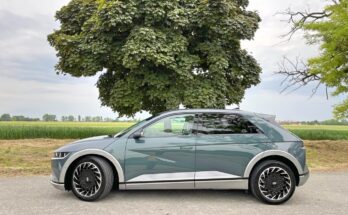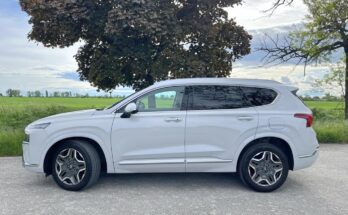
We tested the new Hyundai Tucson N Line to see if it could compete in the increasingly competitive SUV segment with other rivals.
The automaker does it similarly to other sports equipment levels offered by competitors, such as the Volkswagen Tiguan (R-Line), Ford Kuga (ST-Line) or Renault Kadjar (GT Line). The Tucson N Line is the second Hyundai model, after the i30, to receive the N mark.

On the outside, the N Line trim has been given a unique look to stand out significantly from the rest of the Tucson lineup. The front has a sleek looking bumper design which, like its i30 N Line cousin, has small 'shark tooth' elements that protrude from the front under-bumper. There is also a new grille, which correlates with that of the i30 N Line model, and last but not least, LED daytime running lights in the shape of a boomerang. The Tucson N Line received an anthracite mask, black background lights and black intake holes in the bumper. You can also find the same paint on the rear-view mirrors, window frames and roof racks, as well as on the 19-inch wheel discs and the rear diffuser. The black accents contrast nicely with the bright red bodywork.

Inside, we also find red accessories that highlight the otherwise completely black cabin. The seats are trimmed in a combination of artificial leather and Alcantara with an accessory in the form of an embossed "N" edition emblem, and the automatic transmission lever also bears the line's insignia. This trim level gives you everything you need: heated front and rear seats, heated steering wheel, keyless entry, automatic dual-zone climate control, front / rear parking sensors with 360º cameras, electric trunk opening, tinted rear windows and many other extras. In the series, you will also get powerful Krell equipment with nine speakers or full-LED lights.

The model we tested was also equipped with an electric panoramic roof, which extends above the rear passengers, and the front part is opening and also retractable. It is controlled very intelligently and the children are delighted with it. Unlike the panoramic roofs in middle-class station wagons, it does not reduce the space above the head and is very well thermally isolated after pulling the thick black screen.
The interior of the Hyundai Tucson, even after modernization, has not lost any of its original qualities. So it is still functional, spacious and well-made. But it's the same as any other Tucson except for a few details, and it lacks a bit of liveliness in the upper part of the dashboard.

The dashboard layout is more functional than particularly interesting, quality is fine and the eight-inch touchscreen infotainment system is intuitive to operate. Space for rear passengers is quite decent in this class, but the middle rear seat is too narrow for an adult. However, the cabin is very spacious for a family with children. The rear positions do not even offer a sliding bench, but they allow you to fold the backrest further into the luggage compartment. It has a volume of 488 liters and regular shapes, so it can easily be used to its full potential. The tested piece even had a full reserve under the salary.

But let's move slowly to what makes the N Line equipment interesting. Under the hood of the tested unit was a 1.6 T-GDi turbocharged unit with an output of 130 kW (177 hp), connected to a 7-speed dual-clutch gearbox. The engine delivers its maximum at 5500 rpm with a torque of 265 Nm at 1500-4500 rpm. The Tucson can reach 100 km/h in a decent 9 seconds and has no major problems with dynamics when overtaking above the highway speed limit. The only minor problem is the dual-clutch automatic, which sometimes hesitates for a long time about which gear to select and when to downshift. Otherwise, it shifts smoothly, almost like a classic automatic with a hydro-converter. In standard mode, the engine feels a little uncomfortable at the lower end of the rev spectrum, but just switch to Sport mode and everything changes. In this mode, we drove approx. 80% of the time, because only here can the full potential of the engine be used.

And here is the stumbling block – consumption. When we drove in the Normal mode at the beginning of the test and tested how economical the engine can go with moderate driving, we did not get below the limit of 9.4 l/100 km. In Sport mode, we ended up with brisk to sharp driving at 11l/100km. So it doesn't lack appetite, but it will repay you with flexibility and a nice sound at higher revs. The manufacturer indicates a combined consumption of 8.3-8.9 l/100 km. However, it is a bit much these days and I know similarly powerful petrol units that can drive with much lower consumption – even in an SUV of the same size.

However, what the Tucson N Line excels at is clearly the chassis. The N Line received a stiffer suspension, eight percent in the front and five percent in the rear. The Tucson does not disappoint even in the turns, thanks to the steering, which is fast and precise, and the chassis, which provides an optimal ratio between stiffness and a comfortable ride, does not crash on bumps, and the vehicle is stable even during maneuvers at higher speeds. However, the higher center of gravity cannot be fooled and you will find its limits very easily. The wheels are shod with 245/45 R19 Continental Conti Sport Contact 5 SUV tires.
Our test model was in the 4×4 version, which Hyundai calls HTRAC. Traditional four-wheel drive systems are intended more for off-road conditions and are generally not very effective on classic roads. Hyundai has combined the capabilities of the 4WD system with the power and full efficiency of front-wheel drive. Although the AWD system is always active, the front axle is primarily driven and the rear is engaged as needed. You can feel it even when exiting a corner sharply, and you can choose to display the current drive on the display. However, you can of course switch on the quad bike permanently.

Hyundai Tucson N Line with 1.6 T-GDI engine, manual and front-wheel drive starts at approx. 27 thousand euros. For the 4×4 drive, automatic transmission and 1.6 T-GDI 130 kW (177 hp) engine, you will pay approx. 3 thousand. You will pay a total of €32,700 for the highest N Line+ equipment, and for this money you will get an extravagant and very dynamically driving SUV that will be the center of attention everywhere.
| Technical specifications | Hyundai Tucson N Line + 1.6T-GDi 7AT |
| Engine type: | Spark plug |
| Cylinders / valves: | 4 / 16 |
| Displacement (ccm): | 1591 |
| Highest power (kW(k) / rpm) | 130 (177) / 6000 |
| The highest twist. torque (Nm / rpm): | 265 / 1500-4500 |
| Gearbox: | 7th century automatic |
| Acceleration 0 – 100 km/h (s): | 9.1 |
| Combined consumption – WLTP (l/100 km): | 8.3 – 8.9 |
[rl_gallery id=”6691″]




